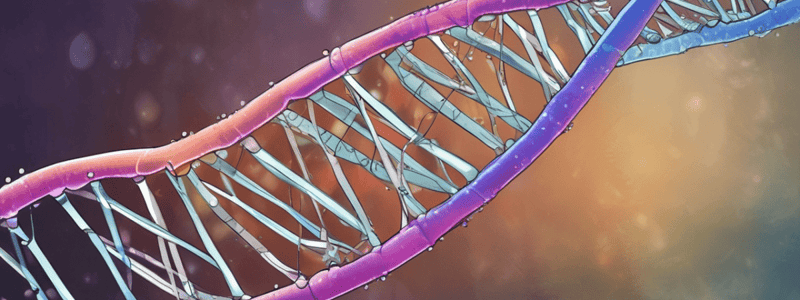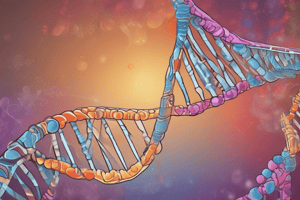Podcast
Questions and Answers
What is the primary function of the S phase in the cell cycle?
What is the primary function of the S phase in the cell cycle?
- Cell entry into quiescent phase
- Chromosome segregation
- DNA synthesis (correct)
- Cell preparation for mitosis
What is the approximate percentage of the human genome that encodes proteins?
What is the approximate percentage of the human genome that encodes proteins?
- 51%
- 20%
- 4%
- 1% (correct)
What is the name of the short interspersed elements that are 160bp repeats?
What is the name of the short interspersed elements that are 160bp repeats?
- Satellite DNA
- SINES (correct)
- LINES
- Transposons
What is the term for the problem of chromosome ends?
What is the term for the problem of chromosome ends?
What is the primary function of the G1 phase in the cell cycle?
What is the primary function of the G1 phase in the cell cycle?
What is the term for the repeated sequences found in the human genome?
What is the term for the repeated sequences found in the human genome?
What is the number of pairs of chromosomes found in human cells?
What is the number of pairs of chromosomes found in human cells?
What is the term for the mobile genetic elements that are derived from retroviruses?
What is the term for the mobile genetic elements that are derived from retroviruses?
What is the role of topoisomerase in DNA replication?
What is the role of topoisomerase in DNA replication?
What is the purpose of the RNA primer in DNA replication?
What is the purpose of the RNA primer in DNA replication?
What is the direction of DNA synthesis in the leading strand?
What is the direction of DNA synthesis in the leading strand?
What is the role of helicase in DNA replication?
What is the role of helicase in DNA replication?
What is the result of the loss of telomeres?
What is the result of the loss of telomeres?
What is the primary function of DNA polymerase?
What is the primary function of DNA polymerase?
What is the result of a nonsense mutation?
What is the result of a nonsense mutation?
What is the purpose of DNA ligase in DNA replication?
What is the purpose of DNA ligase in DNA replication?
What is the role of the Shelterin complex in telomere function?
What is the role of the Shelterin complex in telomere function?
What is the result of the Philadelphia Chromosome translocation?
What is the result of the Philadelphia Chromosome translocation?
Study Notes
DNA Replication and Mutagenesis
Overview of DNA Replication
- DNA replication is part of the cell cycle in eukaryotic cells
- It occurs during the S phase of the cell cycle
- The process involves the unwinding of DNA, synthesis of new strands, and the formation of replication forks
Structure of the Human Genome
- The human genome consists of 23 pairs of chromosomes
- The total number of nucleotides is approximately 3.2 x 10^10
- Only 1% of the genome encodes proteins (20,000 genes)
- Regulatory regions of genes make up about 4% of the genome
- Other unique sequences account for about 44% of the genome
- Repeated sequences, including LINES, SINES, and satellite DNA, make up about 51% of the genome
Initiation of Replication
- Replication begins at the origin of replication
- The double helix is unwound, and the bases are exposed
- DNA polymerase synthesizes new strands using the parental strands as templates
- The process is semi-conservative, resulting in two new DNA molecules, each containing one parental strand and one daughter strand
The Replication Fork
- The replication fork is the region where the DNA is unwound and replication occurs
- Helicase unwinds the DNA, and single-strand binding proteins stabilize the single-stranded DNA
- Topoisomerase breaks a phosphodiester bond in one parental strand to prevent supercoiling
- The leading strand is synthesized continuously, while the lagging strand is synthesized in short, discontinuous segments called Okazaki fragments
Role of Enzymes in DNA Replication
- Helicase: unwinds DNA strands
- Topoisomerase: releases supercoils in DNA
- Single-strand binding protein: stabilizes single-stranded DNA
- Primase: makes RNA primer for DNA synthesis
- DNA polymerase: synthesizes DNA
- Exonuclease: removes RNA primer
- DNA ligase: joins adjacent Okazaki fragments
Fidelity of DNA Replication
- DNA polymerase has a proof-reading mechanism to correct errors during DNA synthesis
- The enzyme also has a 3'-5' exonuclease activity to remove incorrect nucleotides
Origins of Replication
- There are multiple origins of replication per eukaryotic chromosome
- Bacterial chromosomes are circular and have a single origin of replication
Chromosome End Problem
- The end of the chromosome is lost during DNA replication due to the inability of DNA polymerase to synthesize DNA at the very end of the chromosome
- Telomeres, specialized structures at the end of chromosomes, consist of hundreds of repeats of the sequence 5' TTAGGG 3'
- Telomeres shorten with every round of DNA replication, leading to cellular senescence
Types of Mutation
- Point mutation: a single base is changed
- Silent mutation: a change that does not affect the encoded amino acid
- Missense mutation: a change that affects the encoded amino acid
- Nonsense mutation: a change that results in a stop codon
- Small scale insertions or deletions: indels
- Large scale changes to chromosomes: inversions, deletions, duplications, translocations
Cause of Mutagenesis
- Spontaneous errors in DNA replication
- Replication slippage associated with repetitive regions
- DNA damage caused by spontaneous deamination, UV radiation, ionizing radiation, and alkylating agents
- Most DNA damage is repaired through direct repair, nucleotide excision repair, or homologous recombination
Chemotherapy Drugs
- Methotrexate: inhibits the synthesis of thymine
- Doxorubicin: binds to DNA and prevents the action of topoisomerase
- 5-fluorouracil: inhibits the synthesis of thymine
Studying That Suits You
Use AI to generate personalized quizzes and flashcards to suit your learning preferences.
Description
This quiz covers the fundamentals of molecular and cellular genetics, including DNA replication, mutagenesis, and the chromosome end-problem. Understand the chemistry and structure of DNA/RNA and appreciate the clinical importance of DNA mutations.



